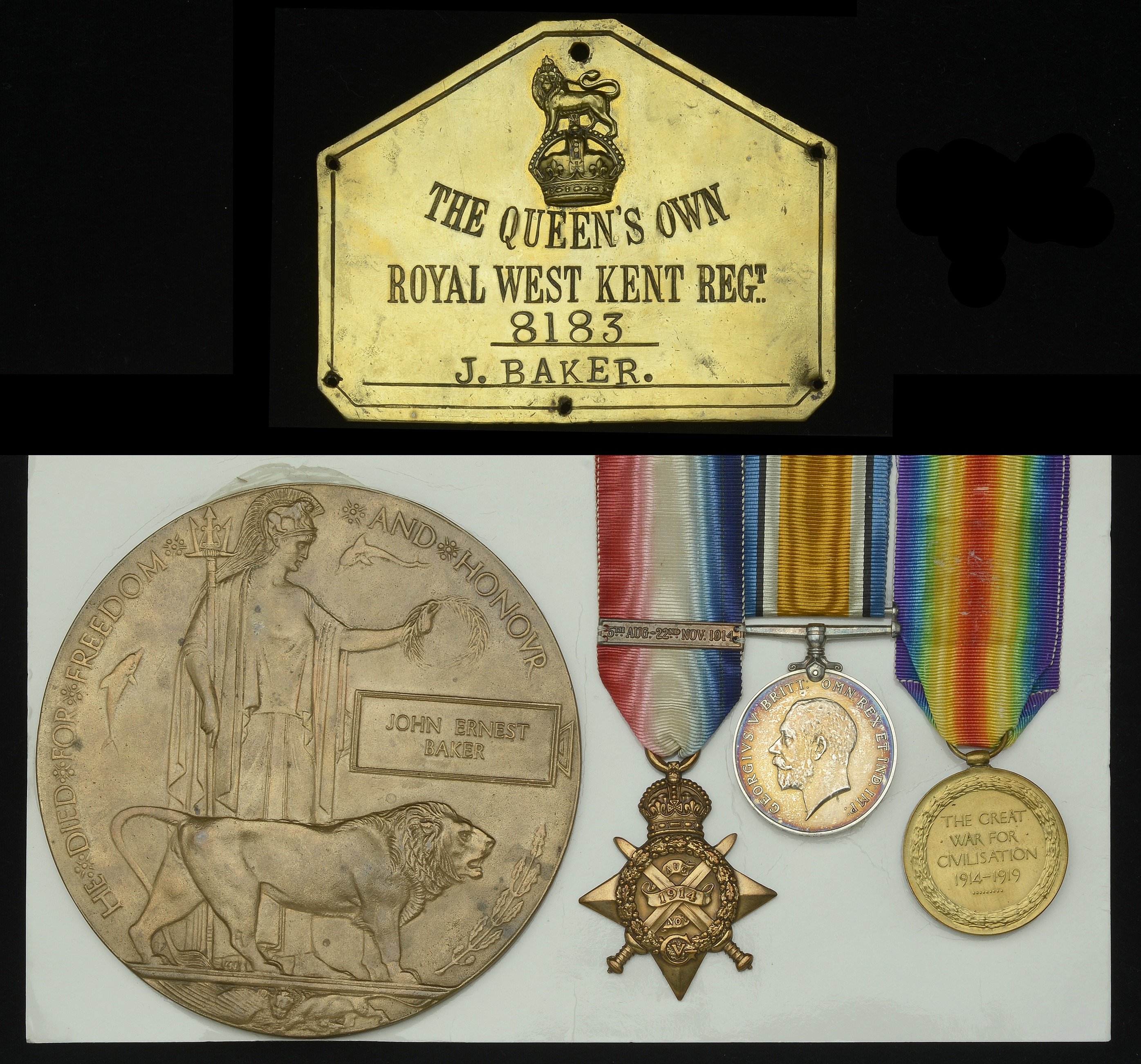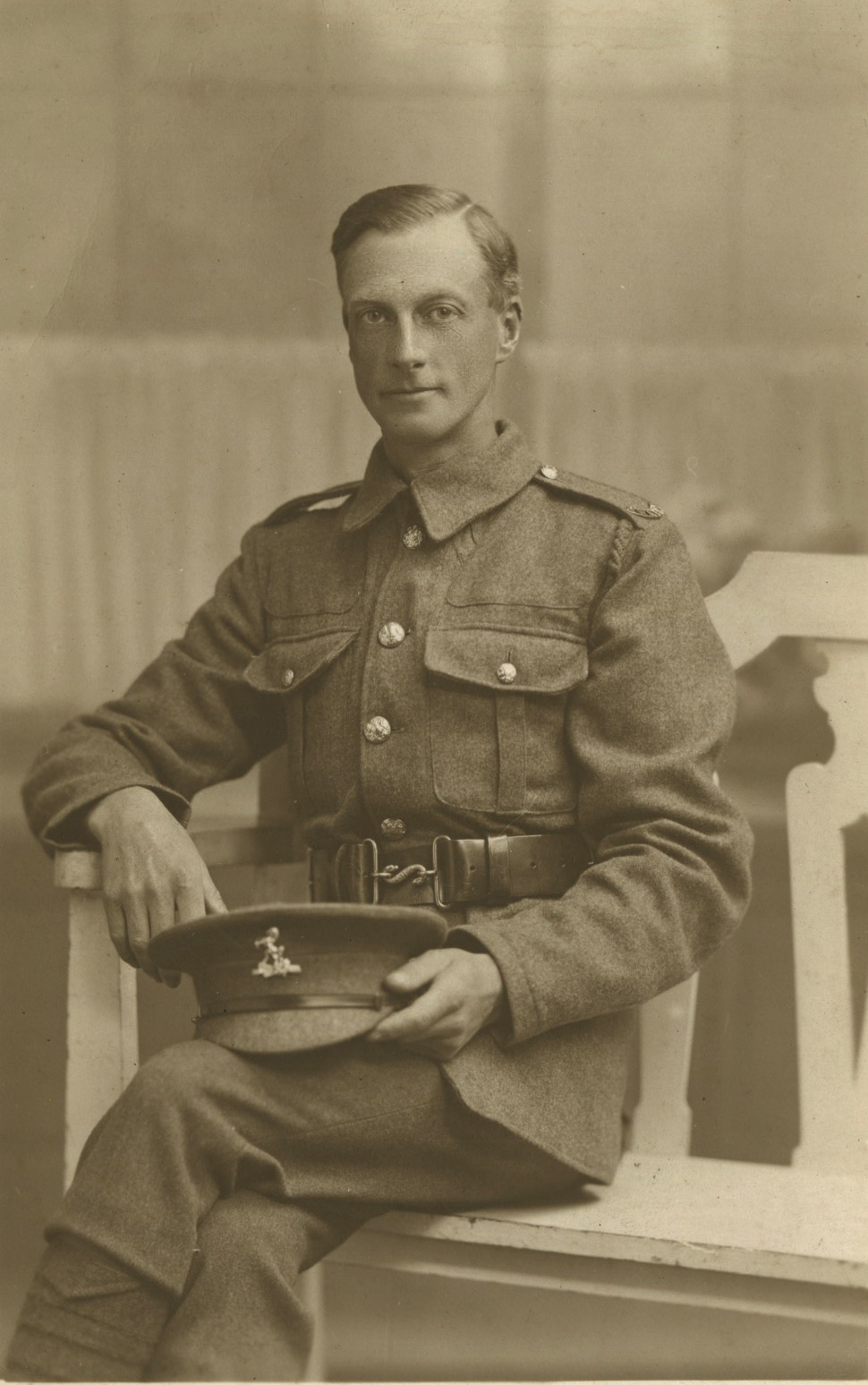Three: Private J. E. Baker, 1st Battalion, Queen’s Own (Royal West Kent Regiment), who was killed in action during his battalion’s epic defence of its isolated trench near Neuve Chapelle on 24 October 1914 1914 Star, with copy clasp (L-8183 Pte. J. E. Baker. 1/R.W. Kent R.); British War and Victory Medals (L-8183 Pte. J. E. Baker. R.W. Kent. R.); Memorial Plaque (John Ernest Baker) with Buckingham Palace enclosure; together with a brass ‘Bed Plate’ inscribed, ‘The Queen’s Own. Royal West Kent Regt. 8183. J. Baker.’, good very fine (5) £300-£400 --- John Ernest Baker was born in 1887 at Woolwich, Kent. He attested for the Royal West Kent Regiment at Maidstone in 1905 and served with the 1st Battalion during the Great War on the Western Front, landing at Le Havre on 15 August 1914. He was killed in action during the Battle of La Bassée on 24 October 1914 during one of the most epic actions of the 1914 campaign, when his Battalion successfully defended its isolated trench near Neuve Chapelle against overwhelming odds for six consecutive days, 23 to 29 October 1914, losing 13 of its 15 officers and over 450 men, and being brought out of action by two junior subalterns, both of whom were afterwards awarded the D.S.O. In consequence of their heroic defence, the Battalion was the subject of some flattering remarks on the part of General Sir Horace Dorien-Smith, ‘there is one part of the line which has never been retaken, because it was never lost. It was the particular trenches which your battalion held so grimly during those terrific ten days.’ In addition, four men of the battalion were awarded the D.C.M. for this action. Such was the chaos during the period 20 - 31 October, the War Diary of the 1st Battalion, Royal West Kent Regiment for the month of October 1914 is prefaced by the following note by the Lieutenant-Colonel Commanding, ‘Owing to the diary having been in the possession of Capt. & Adjt. G. B. Legard at the time he was killed it has been found impossible to complete it since the 20 October 14 except that part compiled by memory by Lieut. H. B. H. White and 2nd Lieut. J. R. Russell, the two surviving officers with the Battalion who recovered the Diary but were unable to find the appendices referred to.’ C. T. Atkinson in ‘The Queen’s Own Royal West Kent Regiment 1914-1919’ describes the circumstances on 23/24 October: ‘In the new line the battalion was assigned a position which was to become famous in the annals of the Regiment. Just south of Neuve Chapelle the Rue de Bois running W.S.W. to E.N.E. joins the main road from La Bassée, which runs about S.S.E. to N.N.E. towards Estaires. From the road junction (afterwards known as ‘Port Arthur’) a road goes off about N.E., practically continuing the Rue do Bois to Neuve Chapelle. The main road marked the right of the battalion’s line, which extended 400 yards to the left, the front line being 250 yards east of the Port Arthur - Neuve Chapelle road, West of which Battalion Headquarters and the reserve company’s trenches were placed. To the front, turnip fields and ploughed land stretched for about 400 yards to the hamlet of Ligny le Petit, while to the left front and more opposite Neuve Chapelle itself was the Bois de Biez, in those days affording plenty of cover to attacking forces , so that its nearness to the British line was a serious disadvantage. Trenches of sorts had been begun, but they needed all available labour to improve them. Fortunately the delay of the Germans in advancing gave time for the work. It was 2.30 p.m. before their leading scouts reached the houses in front, and soon after that the troops in the front trenches were pretty briskly engaged, finding targets in the Germans who were attempting to establish themselves in the houses, and being heavily fired on in return, though as yet there was little shelling. Of that plenty was to come. During the night of the 23rd/24th B Company heard what sounded like digging going on close to their front, a heavy fire was therefore opened, and the noise soon ceased. At daybreak a good many German corpses along the line of an intended advanced trench testified to the effectiveness of B’s shooting, and during early morning the enemy attempted no advance. But early in the afternoon his guns opened fire, not only field guns, but large howitzers, 6 inches in calibre and more, whose shells, descending at a steep angle, wrecked completely anything they struck. Luckily the soil was soft, which diminished considerably the effect of the bursts, but fire-trenches and dug-outs such as the battalion had been able to make proof against shrapnel could not compete with these ‘Black Marias’, and when these guns got the range of the British Line, as they did on the 26th, the trenches were blown to pieces and many casualties sustained. Luckily more than one alternative position was available and by shifting men about, casualties were to some extent kept down. But the ordeal to which the men were subjected was a severe one, alike for those in the firing-line and for those, equally exposed, in support or reserve. But the worst of it was that the damage done to the trenches by these heavy shells very much diminished the protection they afforded against shrapnel, and gave opportunities to the German snipers and machine-gunners. To repair trenches or to dig out men buried under the débris meant exposure to a stream of bullets.’ Private Baker was the son of Mr and Mrs Edward Baker, latterly of Starbuck House, Giants Grave, Britton Ferry, Glamorgan and, having no known grave, is commemorated on Le Touret Memorial, France. Sold with copied research and two postcard portrait photographs of the recipient in uniform.






